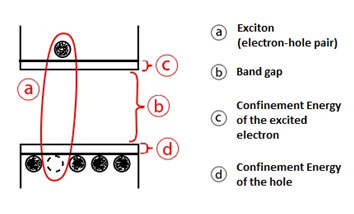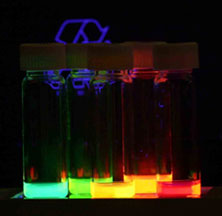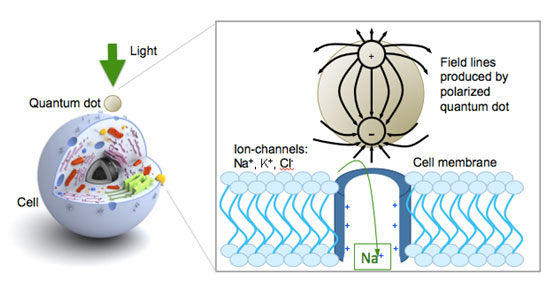Quantum Dots and Cells
Quantum Dots and Cells
Probe that cell! What's it doing? Can we control it? Yes we can! Thanks to quantum dots and the amazing research done by Dr. Lin's and Dr. Rieke's research groups at the University of Washington.1-6 Their groups have shown experimentally that quantum dots can be used to stimulate cells, to probe them, and to trigger neuron firing with light! And all of this probing and switching is done without altering the cell genetically or chemically.
 (a) |
 (b) |
| Figure 1. (a) Toggle switch. Credit: Wikimedia Commons (b) Energy levels for a quantum dot, which can act as a neural switch. Credit: Wikimedia Commons | |
Neurons
Neurons are cells that "fire" in response to a potential difference.7 Usually the potential difference between the inside and outside of the neuron is -0.07 volts, with a higher negative charge within the cell than outside the cell. The neuron "fires" when the potential difference between the inside and outside of the cell reduces to -0.055 V, during which time it opens channels that connect the inside of the cell to the outside and pumps sodium ions (Na+) out of the cell and potassium ions (K+) into it, and sometimes it transfers chlorine ions (chloride or Cl-). Neurons commonly transfer charge with a specific ratio: for every three sodium ions pumped out, two potassium ions are pumped in. This transfer of positively charged potassium and sodium ions continues until the cell is again at its resting potential difference of -0.07 volts. In a previous article discussing work done by Karl Deisseroth and Ed Boyden, it was described how light can be used to control neuron firing,8 however in these studies; the cell had to be altered by introducing a photosensitive molecule onto the surface of the neuron cells of interest. This photosensitive molecule acted as channels when light is shined on it.
Quantum Dots

Figure 2. Each container has identical semiconducting material but with particles of different sizes (quantum dots) that emit different colors of visible light when illuminated with ultraviolet light. The color of light emitted depends on the size of the particle. Image credit: Wikimedia Commons
The study of quantum dots began in the 1980s. Quantum dots are very small amounts of semiconductor material (nanoparticles) whose size affects the allowed energy levels of the material. The electrons of the material usually reside in the lowest band of energy levels called the valence band. When the electron absorbs energy it is excited to a higher band of energy levels, levels called the conduction band, leaving behind an empty spot known as a hole. When the electron returns to the lower valence energy level it emits energy. How far apart the valence band and conduction band are depends on the size of the particle. The size of the particle controls what is known as the confinement energy, Figure 1. This means that the size of the particle can be used to control the different types of light the particles absorb and emit. Quantum dots have been created that absorb ultraviolet light and emit all of the colors of the rainbow depending on their size, rather than just what it is made of.9
Quantum Dots and Cells
How does the quantum dot make a neuron fire? When a quantum dot is excited by light shining on it, it becomes polarized so that one part of the material is more positive and the other is more negative. This in turn sets up an electric field, which can interact with a neuron or other cell of interest. How strong that interaction is depends on how close the polarized quantum dot is to the cell. The closer it is, the stronger the interaction. The strength of the interaction also depends on the type of ion channel on the cell membrane. If the field set up by the quantum dot is strong enough, it can cause the ion channels to open and a transfer of ions out of and into the cell. For a neuron, this is "firing" the neuron or switching it on.
 Figure 3. Quantum dot becomes polarized after absorbing light energy and affects the ion channels of a cell when placed near the cell membrane. Image credit: Lin's research lab at the University of Washington.
Figure 3. Quantum dot becomes polarized after absorbing light energy and affects the ion channels of a cell when placed near the cell membrane. Image credit: Lin's research lab at the University of Washington.Dr. Lin's and Dr. Rieke's research groups tested their idea outside of the body. They grew prostate cancer cells and cortical neuron cells in the lab and placed quantum dots near them. Then they measured the electrical signals of the cell membrane when the quantum dots had absorbed some energy and were polarized. The researchers tested a film of cadmium telluride quantum dots created near the prostate cancer cells. In this situation, they found that the prostate cancer cells survived when cultured on the quantum dots and the potassium channels on the membranes of these cells were activated when the quantum dots were polarized using a mercury light source. A film of cadmium selenium quantum dots was created and cortical neuron cells were cultured on the film. When green light illuminated the quantum dots, the quantum dots absorbed energy and became polarized. The nearby neural cells then depolarized, fired, and after a small amount of time repolarized by opening the potassium or sodium channels on their cell membranes. The researchers noticed that some neurons didn't fire as usual. Some became hyperpolarized, which means that a more negative potential than usual is across the cell membrane due to a larger transfer of ions. The researchers believe that the health of the neuron cells was compromised due to the toxicity of cadmium selenium. They also tested neuron cells using a cadmium selenium probe so that the cortical neuron cells could be cultured in a more suitable environment. Observations using the probe supported their observations using the film.
Current and Future Research
The research described in this paper will likely lead to ways to further probe individual cells, learn their roles, and learn how we might be able to control cells to help treat diseases. One of the great advantages to using quantum dots is that antibodies can be attached to them. This allows targeted cell delivery within the body and is currently being used for biological imaging. Quantum dots are also being used in various applications such as quantum dot lasers, display screens, lighting, and photodetectors. One application of quantum dot technology is flexible display screens.10 Quantum dots are also a likely candidate for a future quantum computer.
References and Links
1. Lugo, K, Miao, X., Rieke, F., & Lin, L, Remote Switching of cellular activity and cell signaling using light in conjunction with quantum dots, Biomedical Optics Express 12 (3), pp 447-454, March 2012.
2. Lin's Lab at University of Washington.
3. Rieke's Lab at University of Washington
4. Lin, L, Quantum dot optical switches for remote control of neurons, SPIE Newsroom, 2012.
5. Carts-Powell, Y., Stimulating Specific Neurons with Light, Optics and Photonics News, 23 (5), pp 10-11, May 2012.
6. de Lang, C., Quantum dots control brain cells for the first time, New Scientist, 14 February 2012.
7. Nobelprize.org, Nerve Signaling
8. Doss, H.M., Mind over matter, light over mind, APS Physics Central, Physics in Action 2011
9. Wikipedia
10. Patel, P, The first full-color display with quantum dots, MIT Technology Review 22 February 2011
H.M. Doss














